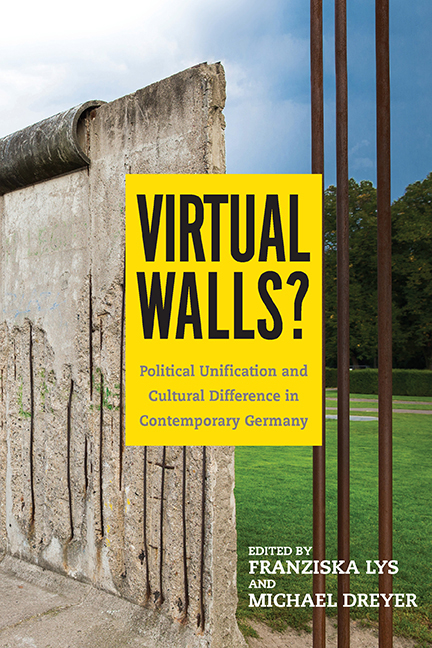Book contents
- Frontmatter
- Dedication
- Contents
- Acknowledgments
- Introduction: United Politics—Divided Culture?
- Part I What Remains: History and the Constitution
- 1 Lost in Transition: Reflections on the Spectral History of the GDR
- 2 Reconstituting the Federal Republic? Constitutional Law and Politics before and since 1989
- Part II What and How Do We Remember? Literature, Film, and Exhibitions
- Part III A Changing Reception: Painting, Orchestras, and Theaters
- Part IV A Virtual Wall? Education and Society
- Epilogue: The Wende and the End of “the German Problem”
- Notes on the Contributors
- Index
1 - Lost in Transition: Reflections on the Spectral History of the GDR
from Part I - What Remains: History and the Constitution
Published online by Cambridge University Press: 24 August 2019
- Frontmatter
- Dedication
- Contents
- Acknowledgments
- Introduction: United Politics—Divided Culture?
- Part I What Remains: History and the Constitution
- 1 Lost in Transition: Reflections on the Spectral History of the GDR
- 2 Reconstituting the Federal Republic? Constitutional Law and Politics before and since 1989
- Part II What and How Do We Remember? Literature, Film, and Exhibitions
- Part III A Changing Reception: Painting, Orchestras, and Theaters
- Part IV A Virtual Wall? Education and Society
- Epilogue: The Wende and the End of “the German Problem”
- Notes on the Contributors
- Index
Summary
Did the GDR Ever Exist?
TWENTY-FIVE YEARS AFTER THE FALL of the Wall, German watchers might be tempted to pose two totally opposing questions about the GDR. The first question is: Did the German Democratic Republic ever really exist? Of course, it did exist, but it seems to have faded such that its historical presence appears pale and unreal—as if a dream that had once been vivid disappeared upon awakening. The second question is the opposite: Doesn't the German Democratic Republic really still exist? Of course, it doesn't, but it seems to have left sufficient habits, traces, and memories that haven't quite faded. This essay is an effort to grasp the ungraspable; that is, to reflect on why and how this forty-year experience retains such a ghostly quality.
Memories are strong; cinematic reconstructions are vigorous. The successor to the GDR's once-ruling party is and has been part of several state-level governing coalitions, and it deeply influences the German “Left.” Most significant, a residual awareness of being a separate half of the country persists, whether in terms of income differentials, habits, regional cityscapes—a bit as if one had traveled into the Italian South or the American South fifty years after unification had brought those regions into their respective national governments. Thus, on the one hand, we recall a state that seems to have been ghostly even when it was real; on the other hand, we confront a spectral presence that still persists. This essay is prompted by that apparent paradox—it is an effort to puzzle through the semisovereign country that never really fully existed and the mental state that never totally disappeared. The history of East Germany encompasses other paradoxes as well. The GDR would never have endured had it not been for Soviet troops who arrived in 1945, who then put down workers’ protests in 1953 and finally allowed the hermetic sealing of the border in 1961. Nonetheless, although it was guaranteed ultimately by an implicit recourse to force, it still generated real loyalties. It governed, on the one hand, through surveillance, but surveillance that was accepted and even shared by a significant fraction of the country's educated classes. And even while surveillance was elevated into a governing principle, it was simultaneously mobilized for civic efforts, peace campaigns, and competitive sports. The GDR hovered between repression and enthusiasm.
- Type
- Chapter
- Information
- Virtual Walls?Political Unification and Cultural Difference in Contemporary Germany, pp. 19 - 38Publisher: Boydell & BrewerPrint publication year: 2017

